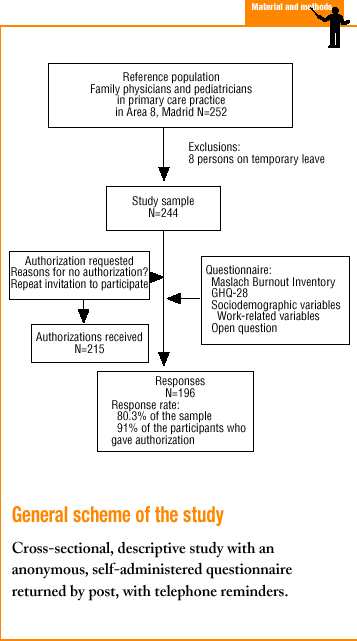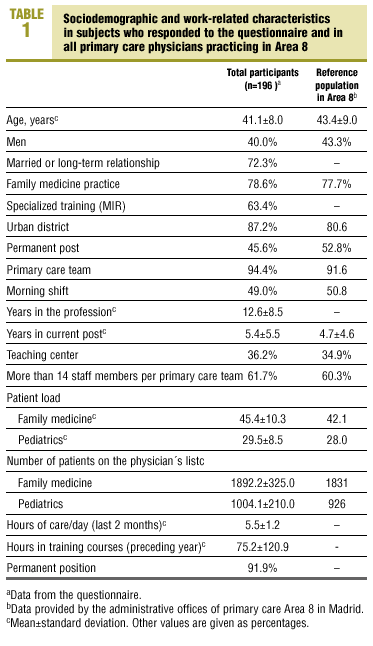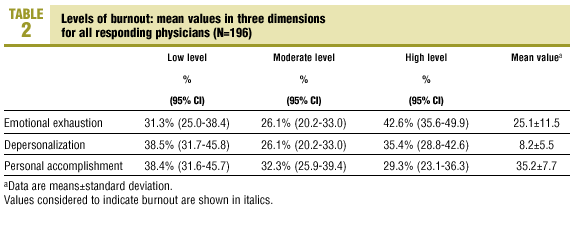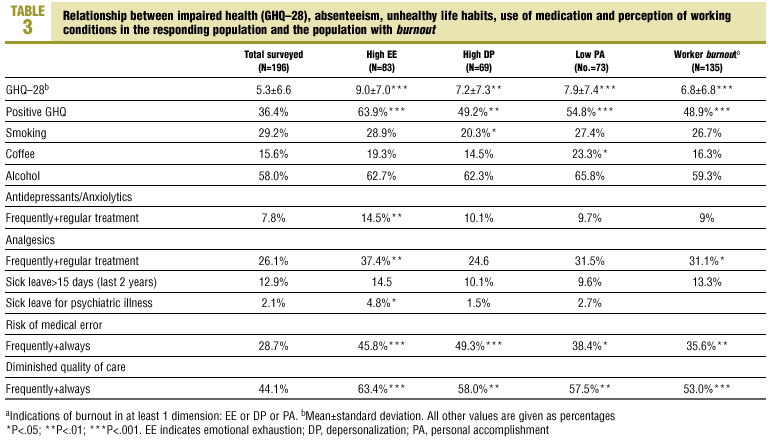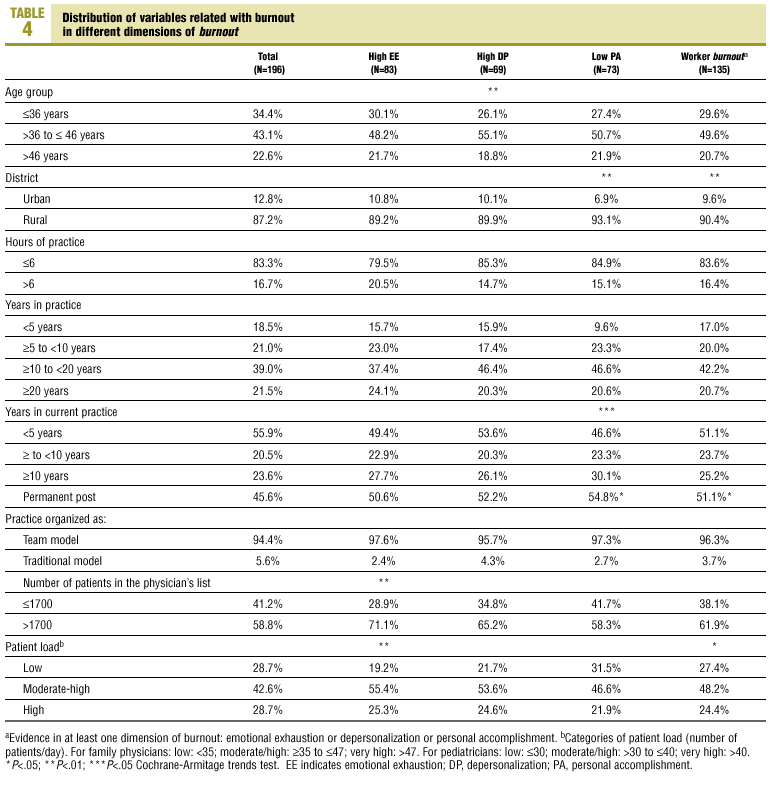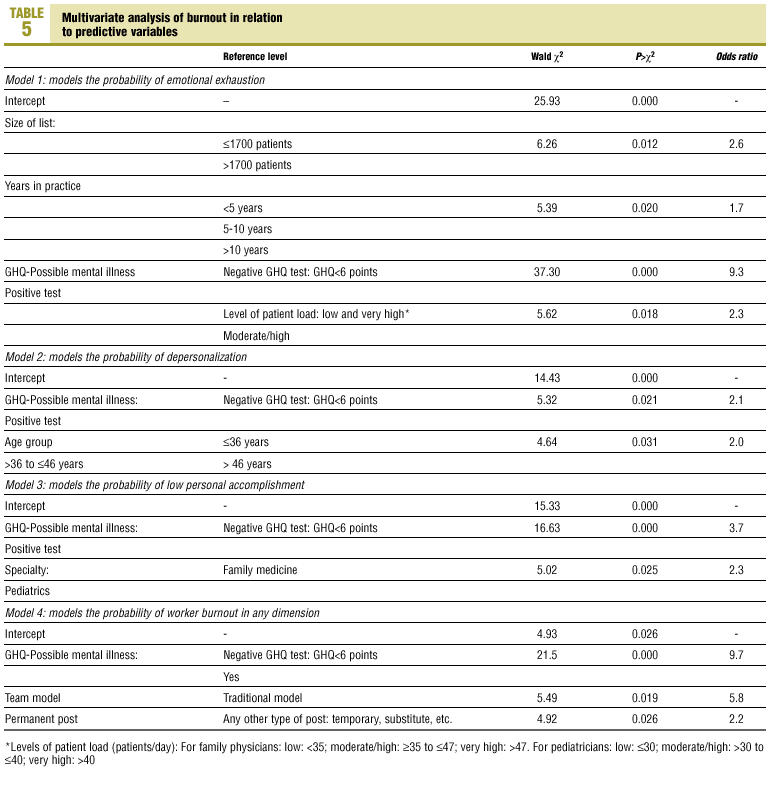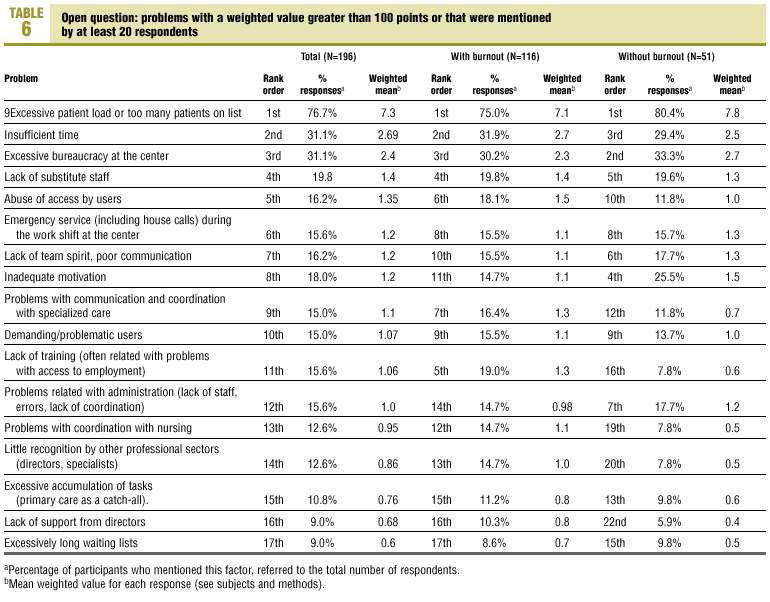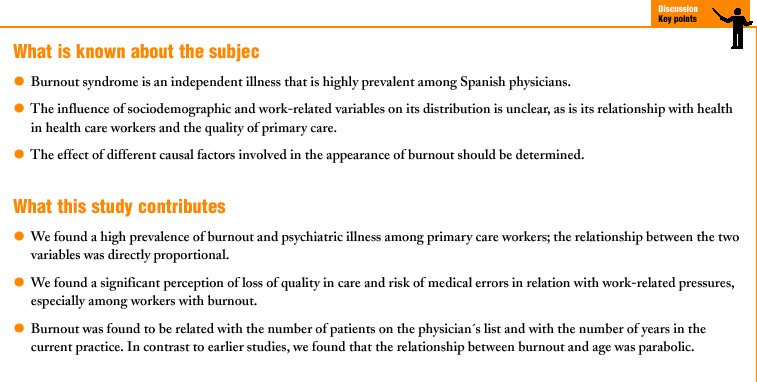Introduction
Burnout syndrome, described by Freudenberg en 1974,1 consists of a progressive loss of energy in workers in the helping professions, with resulting changes in behavior. Maslach and Jackson2,3 developed this concept, and defined its three characteristic dimensions: emotional exhaustion (EE), i.e., loss of emotional resources to face work; depersonalization (DP) or the appearance of negative attitudes and cynicism toward service receivers; and diminished sense of personal accomplishment (PA) or a tendency to evaluate ones own work negatively, with low professional self-esteem.
In Spain, «worker burnout syndrome» or «burned-out worker» are the expressions used most often to refer to this phenomenon,4,5 which appears to be emerging as a public health problem among Spanish health care professionals.6-12 Among other consequences, behavioral changes, declining health, the appearance of unhealthy life habits and defensive attitudes, and increased absenteeism have been reported.4,5 These changes can lead to decreased efficiency, increased costs and worse quality of care.13-16 To date, the relationships between worker burnout syndrome and employee health or quality of primary health care have been insufficiently investigated. In addition, studies of the associations with sociodemographic or employment-related variables (age, time in current job, patient load and duration of contact with each patient), which have traditionally been associated with the appearance of burnout syndrome, have yielded contradictory results.17
The main aims of this study were to determine the prevalence and distribution of worker burnout syndrome among primary care practitioners in a health care area in Madrid, and to quantify its associations with decreased levels of mental health among practitioners, and practitioners´ perceptions of quality of care. We also set out to evaluate the relationships between burnout and sociodemographic and work-related variables.
Subjects and methods
Participants
The study population consisted of 244 family physicians and pediatricians in practice in Primary Care Area 8 in Madrid (central Spain) during the period from April to June, 2001. As exclusion criteria we used residency (as opposed to permanent employment at the center) and temporary sick leave.
Data collection
The study was done with an anonymous, self-administered questionnaire sent via the health system´s internal mail network. Before the questionnaires were delivered, a cover letter was sent to request written authorization to be included in the study. The reasons for nonauthorization were investigated in telephone interviews. One collaborator at each participating center provided assistance with the study, and telephone reminders were also used.
The questionnaire contained the following parts:
Maslach Burnout Inventory18 (MBI), Spanish version,19 which evaluates worker burnout in the EE, DP and PA dimensions. The results are recorded as three numerical variables (one for each dimension) with the following cut-off values: low EE¾18, moderate EE 19-26, high EE>=27; low DP¾5, moderate DP 6-9, high, DP>=10; low PA¾33, moderate PA 34-39, high PA>=40 (in contrast to the other two scales, higher PA scores indicate increasingly favorable responses).
The General Health Questionnaire (GHQ-28), validated by Lobo et al,20 which measures recent changes in mental health. It consists of 4 subscales (somatic symptoms, anxiety and insomnia, social dysfunction and severe depression), and is useful for detecting possible nonpsychotic psychiatric disorders. This instrument is scored as a continuous variable, with a cut-off score of 5/6 (values>=6 are considered positive).21
A specially designed questionnaire with items about sociodemographic characteristics, training, job characteristics, time at current job, workload, temporary incapacity, unhealthy habits, use of medication, and professionals´ perception of the influence of work-related pressures on the quality of care.
An open question asked professionals to list, in order of decreasing importance, 10 work-related problems identified as causing or triggering stress. The number of times each problem was mentioned was recorded as a weighted value determined by its position in the list (10 points for factors listed as the most important, 1 point for those listed as the least important).
Two pilot studies were done, and no problems were observed with comprehension of the questionnaire items.
Data analysis
The data were entered in a DBASE IV database and analyzed with the SAS statistical software package. To compare the main characteristics of the sample with the population of family physicians and pediatricians in Health Care Area 8, we used a secondary source of data provided by the administrative offices of Area 8. Mean values and standard deviations are reported for variables in the EE, DP and PA dimensions, and the percentage of subjects with high levels of burnout is given for each dimension. We compared means or percentages (or both) for the presence or absence of burnout in each category with Student´s t test or the chi-squared test as appropriate. To evaluate trends we used the Cochran-Armitage trends test. Stepwise logistic regression was used to evaluate the relationship between burnout and other variables with a possible causal role.
Results
Of the 244 physicians who received the questionnaire, 196 responded (response rate 80.3%). There were no statistically significant differences in the demographic or social and employment-related characteristics of workers who responded and the population of all physicians in Area 8 in Madrid (Table 1).
Table 2 shows the levels of worker burnout in each of the three dimensions. High levels of burnout according to at least one dimension were found in 69.2% (95% CI, 62.1%-75.4%) of the participants; burnout in two dimensions was seen in 33.8% (95% CI, 27.2%-40.9%); and evidence in all three dimension was seen in 12.3% (95% CI, 8.1%-17.9%).
The proportion of «possible psychiatric cases» was 36.7% (95% CI, 30.0%-43.9%). The levels of psychiatric illness were significantly higher (50%) in practitioners with burnout (Table 3). The prevalence of psychiatric illness increased (P< .001) together with the number of dimensions that showed evidence of burnout. The presence of burnout was also associated with a greater use of analgesics, antidepressants and anxiolytics, and with a higher percentage of sick leave because of psychiatric illness.
The age group most significantly affected by burnout, especially in the DP dimension, was 37-46 years. Patient load, when categorized as low to high, was not directly proportional to burnout; however, moderate or high patient loads of between 35 and 47 patients/day for family physicians and between 30 and 40 patients/day for pediatricians were associated with significantly more burnout (P<.01) and emotional exhaustion (Table 4). According to the bivariate analysis, professionals who work in an urban setting and those with a permanent post also showed a higher prevalence of burnout. Pediatricians who spent more hours per day at work showed higher levels of emotional exhaustion (P<.01).
The multivariate analysis showed that worker burnout was associated with a permanent post and with practice as part of a primary health care team. Multivariate logistic analysis showed the following associations between burnout and the different subscales: for EE, years at the current post (more than 5 years) and number of patients in the patient list (more than 1700 patients); for DP, age group 37-46 years. For low PA, after possible mental illness was controlled for, being a pediatrician was associated with greater burnout, but when mental illness was not controlled for, years in current practice (more than 5 years) was associated with low PA (Table 5).
Slightly more than one-third of the physicians (36.8%) perceived that work-related pressures diminished the quality of the care they provided frequently, and 7.3% felt that this factor always reduced their quality of care. The risk of medical errors was perceived as frequent by 30%, and as permanent by 0.5%. Differences were found between workers with burnout (42.5% felt that work-related pressures frequently diminished the quality of care, and 10.5% percent felt that this factor always diminished quality of care) versus those without burnout (23.7% and 0% respectively, P<.05) (Table 3).
The response rate to the open question regarding the causes of work-related problems or stress was 68.4% (167 of 196 participants). The problem mentioned most often was clearly excessive workload (excessive patient load or patient lists that were too long) (Table 6).
Discussion
The high response rate in the present study (80.3%), along with the absence of significant differences between the responding population and the reference population, and the fact that the reasons for declining to participate in the study failed to detect clear differences between responders and nonresponders, suggest that our results are generalizable to all primary care physicians in Area 8 in Madrid.
We found a high prevalence of burnout (69.2%) that was slightly higher than the figure reported in other Spanish studies.6,8-10 The prevalence of probable psychiatric illness detected with the GHQ (36.7%) was much higher than the figure reported in studies of the general population, and was at the upper end of the range found for the population of users of primary care services.22-26 Burnout and psychiatric illness were related in a directly proportional manner. A significant proportion of physicians, especially among those with burnout, perceived their workload to diminish the quality of care they provided (in consonance with the results of another study of residents in the USA27), and possibly to induce medical errors. These findings illustrate a worrying situation in primary care, which not only affects the quality of life of its practitioners, but may also compromise the quality and efficiency of care.
A large majority of workers believe that the heavy workload, defined as an excessive patient load or patient list, is the main cause of stress in the workplace. This is consistent with other studies that included an open question similar to the one we used at the end of our questionnaire. Although we found a relationship between size of the patient list (more than 1700 patients) and higher levels of burnout, the relationship we found between patient load (per day) and burnout was not linear, making it difficult to explain the relationship. It may be that there is a threshold number of patient contacts above which physicians stop trying to maintain effective control, or our findings may simply reflect the difficulty of measuring the physician´s workload with quantitative indicators such as patient load. Because the relationship between workload and level of burnout has been clearly established in other professions,28 and appeared in another Spanish study,10 efforts will be needed to test better instruments for measuring the workload of primary care physicians.
Our study provides new information of relevance to the debate on factors that may cause or modulate the appearance of worker burnout syndrome. The findings confirm that practitioners who hold a permanent post are more susceptible (probably because of their lack of expectations for further professional advancement),6,10,27 as are those who have held their current job for more time. Our results suggest a possible influence of size of the patient list on the fact that burnout is less prevalent in rural practices. The relationship between burnout and age showed a parabolic relationship; this may explain the discrepancies--possibly reflecting differences in the cut-off points used to determine age groups--between our findings and those of other studies.6,8,10,12,21,29
Further studies are needed to identify modifiable factors that influence the high prevalence of burnout among primary care physicians, and that go beyond previously proposed, traditional models of causation. Changes in the health system, the uncertainties change brings,30 policies aimed at budgetary restrictions, and increased demands by the user population, together with decreasing professional autonomy and recognition,30-33 may be behind the high prevalence of burnout. More specific factors such as lack of motivation,34 lack of opportunities for promotion, difficulties with high-quality continuing education, and excessive administrative burdens at health centers factors which are more amenable to change should be considered top priorities for prompt examination and correction.
Changes in modifiable features of primary care that lessen worker burnout would not only mean better quality of life and improved health for practitioners, but might also help to improve the quality of care, to enhance the capacity of primary care to provide solutions to patients´ problems and prevent unnecessary referrals, to decrease absenteeism and its attendant costs, and to generally improve the efficiency of the use of available resources. .
Acknowledgements
We would like to express our sincerest appreciation to all family physicians and pediatricians who participated in the study, which was made possible by their generous cooperation. We also thank the administrative offices of Health Area 8 in Madrid for their support.
Correspondence: Antonio Molina Siguero. C/ Alfonso XII, 8. 28670 Villaviciosa de Odón, Madrid, Spain. E-mail: acyamolinas@tiscali.es
Manuscript received 28 October 2002.
Manuscript accepted for publication 11 December 2002.





